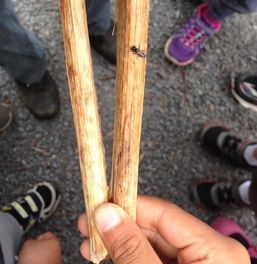
This spring, I had a wonderful experience showing my garden club kids at Windsor Park School how to tie together dry sunflower stalks to make bundles and hang them in protected areas for the pollinators. While inspecting some older stick bundles back at home, I found one with two cells, presumably with wild bee larvae. I took this stick to the school and showed the children. A week later, I realized I had forgotten to put that stick with the larvae back in my yard, and it was still in my garden club box when I gathered the children for another session. To our surprise and delight, the bees had just hatched and two tiny, black bees were sitting on the stick and then flew away into the school garden.
If you want to make your own stick bundles for pollinators, you will need to save stalks in the fall from sunflowers or perennials that have thick stems. The sticks should be at least 6 inches long, tied together and hung under an overhang, ideally facing east. Wild bees will create cells to lay eggs, provision them with food and then seal them off for protection.
The same idea applies to deep holes drilled in wood. You can drill holes in stumps or untreated wood beams. The holes can range in size from 1/8" to 5/16" in diameter, and as deep as the drill bit will allow, but 6 inches would be ideal.
Another option is to roll paper around a thin stick and close off one end. Remove the stick, and place bundles of these paper tubes inside a water proof container, then secure it in an east-facing location that is protected from rain.
For information on more elaborate pollinator homes, you can visit the Edmonton and Area Land Trust website and download instructions and plans.
I have several pollinator homes in my yard, and I also have many kinds of native and non-native flowering plants that provide a source of nectar and pollen for the bees. The combination of flowers, a source of water and wooden homes or stick bundles create the right conditions for pollinators to stick around. The benefit is more beneficial insects and better plant pollination.




 RSS Feed
RSS Feed